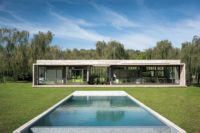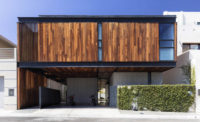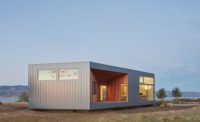When Jerome Engelking’s in-laws asked him to design a vacation home on a wooded plot of land in Amagansett, on Long Island, he found it the perfect opportunity to do what he thinks any architect would dream of doing: build a glass house. “The site spoke to the idea,” he says. “It was virgin land—I didn’t want to whack everything down and make some big, formal statement.” But first, he had to convince the in-laws, who had some concerns about privacy. According to the French-born Engelking, who is a senior associate at Richard Meier + Partners Architects, his father-in-law came around after seeing pictures of Philip Johnson’s Wiley House in Connecticut. “He liked the idea of looking at nature rather than walls,” says the architect. What he didn’t like, however, was the idea of steel, which he found too austere. Being from Austria, he and his wife wanted a warm and casual setting for spending summers with their adult children and eight grandkids, all based in New York. So Engelking proposed an all-timber structure.
Additional Content:
Jump to credits & specifications
For the architect, the project, which he designed in his spare time, was a chance to experiment with a prefabricated building system that would merge the structural frame with the glass envelope. After some research, he found a Quebec-based manufacturer, specializing in energy-efficient timber curtain walls, that could combine the load-bearing columns and the glazing support into easily transportable elements. Within six days, the entire skeleton of Southern Yellow Pine glulam beams and mullions was assembled on-site, for the “most pleasant construction experience I’ve ever had,” says Engelking.
In the middle of the 3.2-acre site, the architect depressed the land to create a grassy clearing, and placed the one-story, 12-foot-high house toward its edge, so that the lawn serves as the backyard, and the front facade, to the east, is protected by a retaining wall formed against the dip in grade. Using 5-foot modular increments as his base, he divided the simple, rectilinear plan into a private wing, to the north—which comprises the master suite, two bedrooms, and a flexible lounge space—and a social wing, to the south, with the combined living, dining, and kitchen area; he organized the living spaces so they have access to the back garden along the west wall, while the bathrooms, kitchen, and laundry are arrayed along the east.
Although fully glazed, Engelking made moves to visually protect the interior from outside eyes, though “the only spectators lurking about are deer,” he jokes. In fact, as one approaches the front facade, which is clad with vertical slats of cedar, the residence doesn’t seem like an all-glass house. It is not until one enters that the full effect of transparency is realized; as you walk in, the woody surroundings become one with the house. To provide privacy for the living and dining area and bedrooms, as well as to mitigate heat gain, Engelking placed automated thermally modified wood blinds on the exterior of the west facade. The blinds are usually lowered only during the afternoon, when the sun is strongest, although they sometimes come down at night too.
Throughout, wood is the only expressed material. Its presence is felt everywhere—the vertical mullions, the exposed plank ceiling, the built-in surfaces in the kitchen and bedrooms—but subtly, just enough to lend that sense of warmth that Engelking’s in-laws wanted. Cozy and minimalist might not be words that often go together, but the house is both—especially when the eight kids, parents, and the grandparents all flock here during the summer months.
It’s a big family for a relatively small building but, according to Engelking, they make it work. One bedroom, which he dubs the “party room,” has two sets of bunk beds and a convertible sofa, and the lounge space doubles as a sleeping area when the other rooms are occupied. Yet having everyone stay overnight at the same time is not the usual scenario, explains the architect, as people come and go; during the non-summer months, both his family and his sister-in-law’s use the house as a weekend getaway. It’s a tight fit regardless, but “my father-in-law is very informal—he wanted it to be festive,” he says. “For us, it’s like a camping ground.”
CreditsArchitect: Jerome Engelking
Engineers: Stutzki Engineering (structural); Fusion Systems (mechanical) |
SpecificationsStructural wood frame glazing IC2 Technologies
Glue-laminated timber Art Massif
Exterior blinds Skirpus
Sliding doors Xinnix
Custom woodwork Vitsoe
Solid surfacing Corian
Lighting Artemide (interior ambient); Luminii (LED strips); Litelab (tracklights); B-K Lighting (facade)
Radiant heat floor Uponor |













Post a comment to this article
Report Abusive Comment